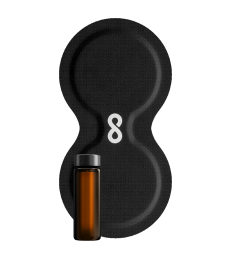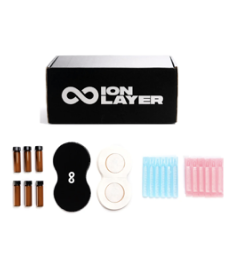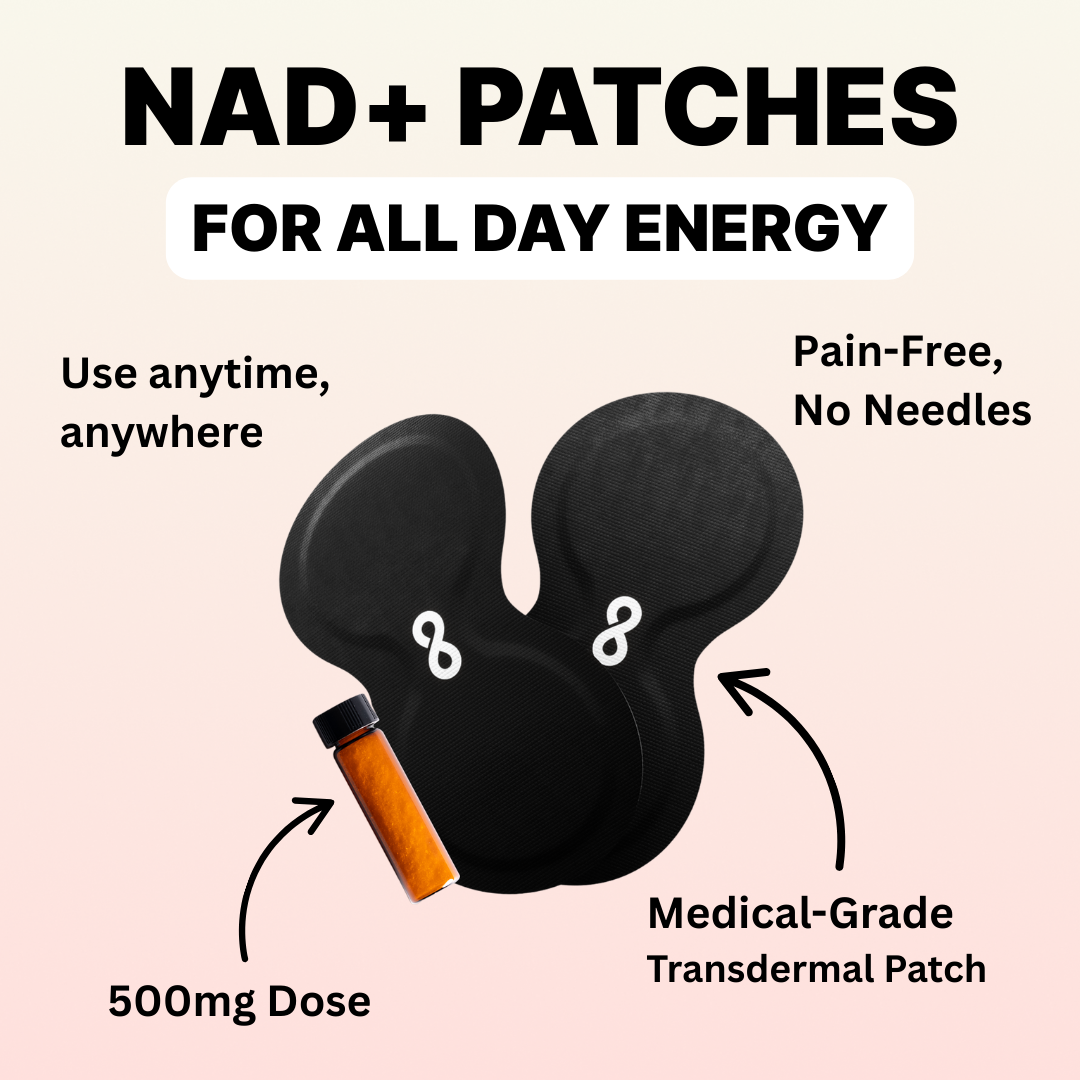
The quest for optimal health is a multifaceted journey. Everything is interlinked from what you eat, do, feel, think or even exposed to. One well-know element in this journey is NAD+ (Nicotinamide Adenine Dinucleotide), an important coenzyme found in every cell of our body, essential for numerous biological processes. What makes this tale truly compelling is the power we hold in shaping NAD+'s fate through our lifestyle choices. From the foods we savor to the activities we embrace, each decision can impact the levels of this remarkable molecule.
These choices can either enhance or deplete our NAD+ levels, which in turn impacts our overall health and wellbeing. Let’s delves into the intricate relationship between NAD+ and lifestyle habits, providing a comprehensive guide on how to maximize NAD+ levels for optimal health.
What is NAD+ and why it's essential
NAD+ is a vital coenzyme found in all living cells. It plays an integral part in energy metabolism, DNA repair, and redox reactions (reducing oxidative stress), where it shuttles electrons from one molecule to another, facilitating energy production.
NAD+ also regulates sirtuins, a group of proteins that influence cellular processes like gene expression, stress response, and longevity. Maintaining a balance of NAD+ levels in our cells is key for optimal cellular function and overall health. As we age, our NAD+ levels naturally decline, contributing to various age-related conditions such as neurodegenerative diseases, metabolic disorders, and cardiovascular ailments. Understanding how to maintain optimal NAD+ levels is therefore essential for promoting healthy aging.
The impact of diet on NAD+ levels
The type, timing, and quantity of food we consume significantly influence our NAD+ levels. Certain dietary habits can negatively impact the availability of NAD+ within our cells, leading to adverse health outcomes.
A balanced diet rich in macro- and micronutrients lays the foundation for health and well-being. Limited calorie intake is a strategy often recommended for ensuring increased lifespan and health. In fact, a caloric restriction of 25-60% relative to a normally fed control has been reported to significantly increase lifespan in different model organisms.
On the molecular level, caloric restriction stimulates the NAD+ salvage pathway, leading to increased NAD+ bioavailability. Additionally, intermittent fasting has been shown to increase NAD levels. By giving the body a break from constant food intake, fasting allows the cells to repair themselves, upregulate autophagy, and boost NAD production.
Moreover, consuming certain types of food and commercially available supplements can also increase NAD+ levels. For instance, the intake of amino acid tryptophan or forms of vitamin B3, such as niacin, nicotinic acid, niacinamide, nicotinamide riboside (NR), nicotinamide mononucleotide (NMN), and nicotinic acid riboside (NaR), stimulates NAD+ formation.
The perils of a high-fat & high sugar diet
A diet high in sugar and fat (particularly from vegetable oils) can result in an energy overload, leading to a reduced ratio of NAD+ to its reduced form, NADH, thereby decreasing overall NAD+ levels. Consuming large amounts of calorically rich food with a low AMP/ATP ratio can also lead to decreased NAD+ or NAD+/NADH levels. This condition often results in elevated blood sugar and insulin levels, increased formation of reactive oxygen species, and oxidative stress and damage.
NAD+ and Exercise: A Healthy Symbiosis
Exercise stimulates the body's metabolism, but it doesn’ stop there — in turn it also boosts NAD production. Moreover, exercise promotes better blood circulation, delivering nutrients and oxygen to cells more efficiently. This further enhances cellular function and increases NAD levels.
To get a bit more science-forward, exercise triggers the activation of AMPK, a protein kinase that senses energy demand in cells leading to an increase in intracellular NAD+ levels. Plus, it also triggers an enzyme called NAMPT, that's the magic behind NAD+'s power boost. This, in turn, modulates the availability of NAD+ in the body.
Both aerobic and resistance exercise training have been found to increase NAD+ levels, improving overall health and fitness.
One clinical study found that athletes have approximately twofold higher skeletal muscle NAMPT protein compared with sedentary individuals. However, following a 3-week exercise training, even sedentary group saw a twofold upregulation of the NAMPT protein.
Interestingly, the relationship between exercise and NAD+ is a two-way street. While exercise increases NAD+ levels, maintaining a high NAD+ to NAD+/NADH ratio is essential for reaping the full benefits of exercise and sports activity. Hence, why we love seeing our Ion Layer costumers wearing their NAD+ Patch as they gear up for a workout.
Conversely, a sedentary lifestyle can lead to decreased NAD production. Lack of physical activity slows down metabolism and reduces blood circulation, leading to lower NAD levels in the body.
NAD+ and Sleep
While NAD+ often enters the conversation in the context of increasing energy and focus, it also takes the front seat when it comes to sleep. Keeping a consistent circadian rhythm, the natural internal clocks that regulate our sleep-wake cycle, helps maintain an optimal balance of NAD+ as well. Research has found that NAD+ oscillation is driven by the circadian clock and it modulates the rhythm of many metabolic and cellular processes.
Additionally, the previously mentioned enzyme NAMPT is also at play here where NAD+ levels determine the oscillatory synthesis of this key enzyme in the NAD+ salvage pathway.
As we age, however, the activity of NAMPT, declines, leading to a decrease in NAD+ availability. This decline in NAD+ can disrupt the circadian rhythm, causing changes in its amplitude, period, and phase. Disrupted circadian rhythms have been observed in various diseases such as cardiovascular diseases, diabetes, cancer, and accelerated aging.
One of the many benefits of high-dose NAD supplementation is improved sleep efficiency. The good news is that with each of our Ion Layer patch, you’ll be administering 500 mg of pure NAD+, which will do wonders to your sleep quality.
Stress in NAD+ level fluctuation
Chronic stress can have detrimental effects on NAD+ levels. Prolonged stress activates various pathways that deplete NAD+ resources, leading to compromised cellular function and increased susceptibility to age-related diseases. Not to mention lingering inflammation and oxidative stress, which can further deplete NAD levels.
The more stressed your body is under, the more NAD its ushering to deal with maintaining the energy you need to deal with the constant stress. To counteract that, take some time to incorporate meditation, breathwork or biofeedback into your daily routine. This will allow for your body and mind to de-stress and tap into the parasympathetic, or rest-and-digest, branch of your autonomic nervous system.
Add NAD patches to your lifestyle choices for that extra NAD boost
While our dietary habits, sleep patterns, and exercise routines play significant roles in controlling our NAD+ levels, leveraging innovative solutions like NAD patches can provide an extra boost to our NAD+ levels. The Ion Layer patches, utilize high-dose, 500mg raw NAD+ per patch, provide a direct route to supplement NAD+ levels, complementing the benefits obtained from a healthy lifestyle.
As we continue to understand the complex relationship between NAD+ and our lifestyle choices, we gain valuable insights into how to harness this powerful coenzyme for optimal health. Get your prescription today and increase your NAD+ levels efficiently, effectively and with convenience. No needles, no long hours spent at the clinic, and certainly no discomfort or nausea.







